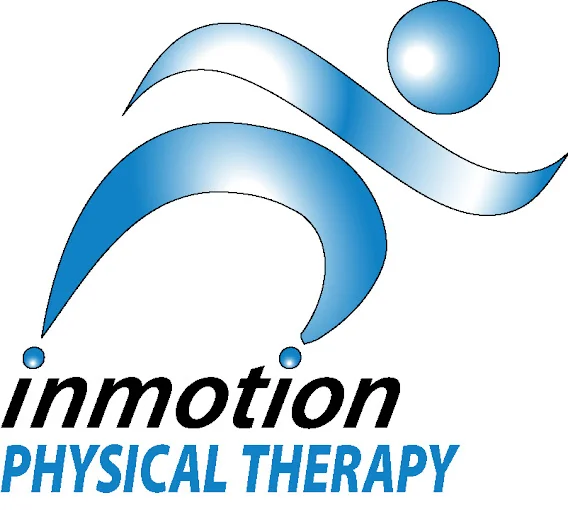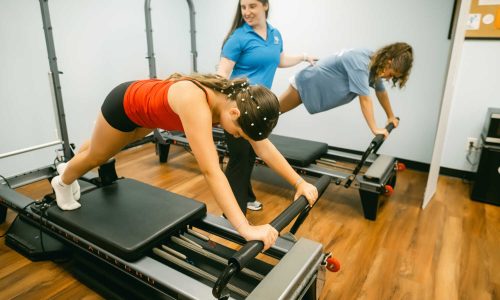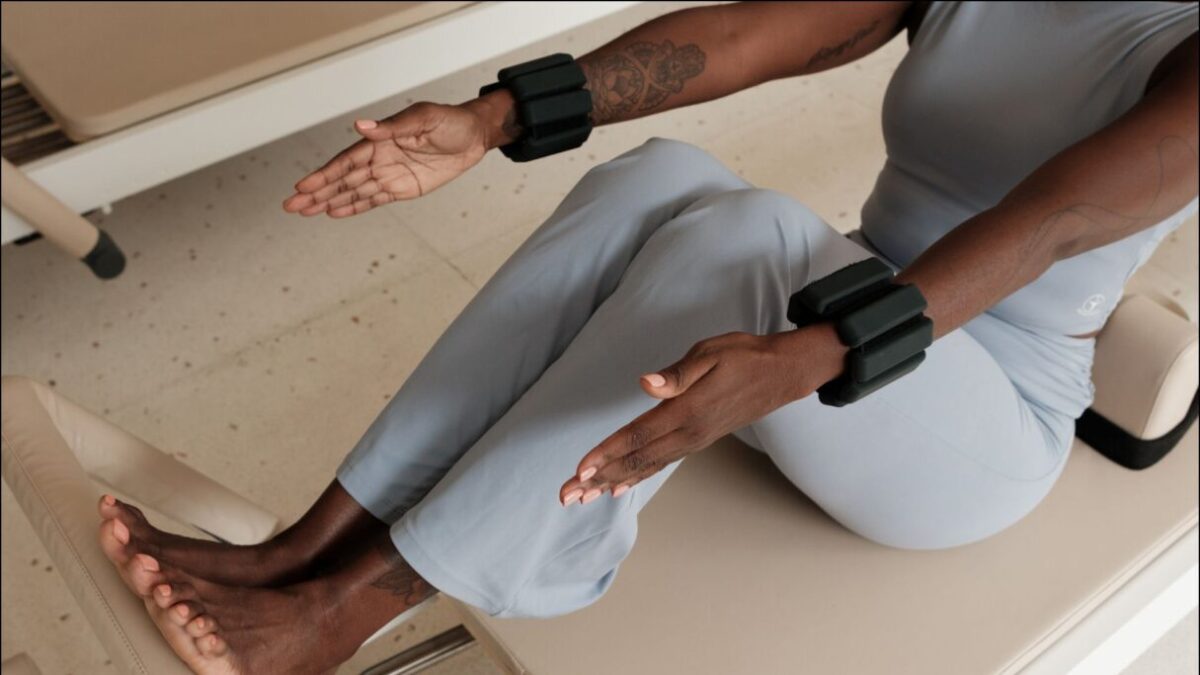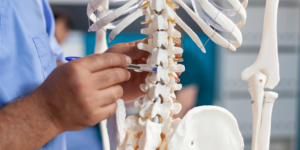As a Doctor of Physical Therapy, I’ve seen firsthand how Pilates can be a game-changer for preventing sports injuries. Pilates offers athletes a unique approach to strengthening core muscles, improving flexibility, and enhancing body awareness that traditional training often misses. In this guide, I’ll share how incorporating Pilates into your routine can help you stay in the game longer and perform at your best.
Ready to strengthen your body’s foundation and prevent those frustrating injuries that keep you sidelined? Let’s dive into how Pilates can be your secret weapon for injury prevention.
What Makes Pilates So Effective for Athlete Injury Prevention?
Don’t just take my word for it — let’s talk about the research.
Multiple studies have shown that Pilates provides athletes with:
- Reduced stress on joints and soft tissues
- Decreased risk of overuse injuries
- Increased protection of spine and pelvis
- Reduced risk of lower back injuries
- Reduced risk of muscle strains
- Enhanced ability to maintain proper form during athletic movement 1
That’s a lot of benefits for one form of exercise! Now you know why so many professional athletes have added Pilates into their training regimen.
Here’s what Pilates offers to athletes that traditional strength training often doesn’t:
Core Strength Beyond Abs
As an athlete, how many times have you heard “you need to strengthen your core”?
I heard it hundreds of times as a soccer player. I could do crunches, sit-ups and planks all day, but I was still getting pushed off the ball during games. The missing key was Pilates.
One of the foundations of Pilates is developing true core strength through the deep stabilizing muscles that support your spine and pelvis during movement.
These muscles — the transverse abdominis, multifidus, and pelvic floor — create what I call your “internal athletic belt.” When these muscles are strong and activated properly, they provide a stable foundation for powerful movement while protecting your spine and joints from excessive stress.
Mind-Body Connection
Pilates isn’t just about going through the motions. It’s about precision, control, and awareness — qualities that can drastically reduce your injury risk.
This heightened body awareness carries over to your sport, helping you notice and correct movement patterns before they lead to injury.
Balanced Muscle Development
Here’s the thing about sports specialization — it creates muscle imbalances. We see it all the time with baseball players, especially pitchers who constantly throw with one arm. These imbalances are injuries waiting to happen!
A study by Neme (2022) confirmed that muscle imbalances significantly contribute to musculoskeletal injuries in athletes.
Pilates addresses these imbalances by working both sides of the body equally and focusing on muscles that are often neglected in sport-specific training. The result? More symmetrical strength and reduced injury risk.
5 Common Sports Injuries Pilates Can Help Prevent
After treating hundreds of athletes over the years, I’ve identified five common injuries that proper Pilates training can help prevent.
1. Lower Back Pain and Strains
Did you know that approximately 80% of adults experience lower back pain at some point? For athletes, especially gymnasts, this number can be even higher due to repetitive movements and high-impact activities.
The core strengthening in Pilates creates a natural “brace” for your lower back. Research shows that activating and strengthening deep core stabilizers provides crucial support during high-impact athletic activities. Pilates also improves flexibility and posture—both essential for proper movement and reducing lower back pain
2. Hamstring Strains
Nothing derails an athlete’s season like a hamstring tear. These injuries are frustratingly common, often resulting from fatigue. They are also slow to heal and have recurrence rates as high as 30%
What many don’t realize is that hamstring injuries often stem from poor muscular endurance or rapid acceleration or deceleration. Pilates addresses both by teaching proper muscle firing patterns and improving the length-tension relationship in the posterior chain through eccentric muscle control.
Pilates exercises like hip rolls, lift and lower with legs in straps, and hamstring curls on the long box provide the eccentric strengthening required to prevent these career-disrupting injuries.
3. Knee Pain and ACL Injuries
Female athletes are up to 8 times more likely to suffer ACL tears than their male counterparts. Why? Often it comes down to movement patterns and neuromuscular control.
Pilates exercises focus on proper alignment and controlled movement, teaching your body how to stabilize the knee joint during dynamic activities. The emphasis on hip and core control directly translates to better landing mechanics and cutting movements in sports.
Research by Çelik and Turkel (2017) demonstrated that Pilates participants experienced significant improvement in quadriceps strength compared to control groups, with improvements across all outcome measurements after just 12 weeks.
4. Shoulder Impingement and Rotator Cuff Issues
For throwing athletes, swimmers, and racquet sport players (yes, you pickleball athletes), shoulder injuries can be career-threatening. Pilates addresses the often-neglected muscles that stabilize the shoulder blade, creating a more stable platform for powerful arm movements.
There is a body of evidence showing an association between scapular dysfunction and shoulder pain, specifically in the overhead athlete.
Pilates exercises like “arm circles” and “swimming” train the serratus anterior and lower trapezius muscles critical for proper scapular movement.
5. Ankle Sprains and Instability
Ankle sprains are among the most common sports injuries, and once you’ve had one, you’re at higher risk for another. Pilates improves proprioception (your awareness of where your body is in space) and strengthens the small stabilizing muscles around the ankle.
The single-leg exercises in Pilates challenge your balance in a controlled environment, training your ankle to respond more quickly to unstable surfaces.
Proprioceptive training programs were effective in reducing the incidence rates of ankle sprains in the athletic population, including those with and those without a history of ankle sprains.
We use exercises like “footwork” on the reformer and “single-leg balance” sequences to develop the ankle stability that prevents those game-ending sprains.
How Pilates Improves Body Awareness and Movement Patterns
What sets Pilates apart from other forms of exercise is its focus on movement quality over quantity. This emphasis creates lasting changes in how athletes move both in training and competition.
Neuromuscular Repatterning
Many injuries stem from faulty movement patterns developed over years of play. Pilates helps “reset” these patterns by:
- Breaking down complex movements into smaller components
- Providing tactile feedback through equipment and instructor cues
- Creating new neural pathways through mindful repetition
- Progressively integrating improved patterns back into functional movements
A fascinating 2023 study used motion capture technology to analyze athletes’ movement patterns before and after an 8-week Pilates program. The results showed measurable improvements in movement efficiency and reduced compensatory patterns during jumping and landing tasks.
The Breath-Movement Connection
In Pilates, breathing isn’t just something you do — it’s a tool for enhancing performance and preventing injury. Coordinated breathing:
- Increases core activation through the relationship between your diaphragm and deep abdominals
- Enhances focus and body awareness during challenging movements
- Improves oxygen delivery to working muscles
- Facilitates recovery between high-intensity efforts
I’ve seen athletes reduce their perceived exertion during competition simply by applying the breathing techniques they learned in Pilates.
Sport-Specific Pilates Exercises
Different sports create different demands on the body. Here’s how we tailor Pilates to specific athletes:
1. Pilates Exercises For Runners
Runners benefit from Pilates exercises that address:
- Hip stability during single-leg stance
- Pelvic rotation control
- Ankle mobility and foot intrinsic strength
- Upper body posture to optimize breathing
Reformer Footwork for Runners:
2. Pilates Exercises For Overhead Athletes (Throwers, Tennis, Volleyball)
These athletes need:
- Scapular stability in multiple positions
- Rotational core control
- Hip-shoulder separation
- Thoracic mobility
Side Plank with Thread the Needle:
3. Pilates Exercises For Team Sport Athletes (Soccer, Basketball, Lacrosse)
These multidirectional athletes benefit from:
- Lateral stability training
- Deceleration control
- Rapid stabilization after dynamic movements
- Rotational power development
Jump Board Work:
4. Pilates Exercises For Gymnasts, Dancers, Figure Skaters
These precision-focused athletes benefit from:
- Balance and proprioception training
- Controlled flexibility development
- Core stability during complex movements
- Postural alignment work
Pilates Plank:
How to Incorporate Pilates into Your Training Routine
As an athlete, or parent of an athlete, you’re probably thinking: “How can I add one more thing to my already packed schedule?” I totally understand! As a mom of 3 who runs a business and trains for half marathons, I know it never seems like there are enough hours in the day. Here’s the good news: Pilates is effective with just 30 minutes, 1-2 times per week!
Frequency and Timing
For injury prevention, aim for 1-2 Pilates sessions per week, with at least one day between sessions to allow your deep stabilizing muscles to recover. These sessions don’t need to be long — even 20-30 minutes can provide significant benefits.
I often recommend doing Pilates on your recovery days between more intense training sessions. The controlled, low-impact nature of Pilates makes it perfect for active recovery while still building crucial stability.
Progression Path
If you’re new to Pilates, start with mat-based exercises focusing on the fundamentals. Once you’ve mastered these, you can progress to using small props like the magic circle or resistance bands to add challenge.
For athletes with access to a studio, reformer work adds another dimension to your training. The resistance and support of the reformer allow you to challenge your body in ways that directly translate to athletic movements.
Success Stories: Athletes Who’ve Benefited from Pilates
Meet Hana, a 12-year-old figure skater who has been incorporating Pilates into her training routine for just a few months. The results have been remarkable.
Before starting Pilates, Hana struggled with maintaining proper balance during complex jumps and spins. Like many young skaters, she was developing muscle imbalances from the repetitive movements required in figure skating.
Since beginning her weekly Pilates sessions with us, Hana reports feeling significantly stronger and more balanced on her skates. Her coach has noticed improved posture and more controlled landings after jumps. Most importantly, she’s been able to avoid injuries that previously sidelined her from training (except for the occasional bruise where her skate hits her heel—an unavoidable part of figure skating!).
Hana’s success demonstrates how Pilates can benefit athletes of all ages, providing the foundation of core strength and body awareness that translates directly to better performance on the ice.
How Pilates Prevents Sports Injuries: FAQ
Get answers to common questions about how Pilates can help keep you injury-free.
How Long Does It Take to See Results from Pilates for Injury Prevention?
Most athletes notice improvements in body awareness and movement quality within a few sessions. For measurable changes in strength and stability that translate to injury prevention, consistent practice for 8 weeks typically produces significant results. (Yu, Jae-Ho and Lee, Gyu-Chang. ‘Effect of Core Stability Training Using Pilates on Lower Extremity Muscle Strength and Postural Stability in Healthy Subjects’. 1 Jan. 2012 : 141 – 146.)
Is Pilates Better Than Weight Training for Preventing Sports Injuries?
Pilates and weight training serve different but complementary purposes. Weight training builds the prime mover muscles that generate force, while Pilates develops the stabilizing muscles that control that force. The ideal approach combines both: Pilates to build your foundation of control and stability, and weight training to develop sport-specific strength and power. As we tell our athletes, “Pilates teaches your body how to use the strength you build in the weight room.”
Can Pilates Help with Recovery from Existing Injuries?
Absolutely! Modified Pilates is a cornerstone of our rehabilitation programs at In Motion Physical Therapy. The controlled, low-impact nature of Pilates makes it ideal for rebuilding strength and movement patterns after injury. The key is working with a qualified instructor who understands both Pilates and rehabilitation principles. We have a physical therapist who specializes in Pilates-based rehabilitation, and we can attest that it’s often a missing link in successful return-to-sport protocols.
How Pilates Prevents Sports Injuries
As athletes, we’re always looking for that edge — something that will help us perform better and stay in the game longer. Pilates offers exactly that by building the foundation of core stability, balance, and body awareness that prevents injuries before they happen.
The athletes I work with who incorporate Pilates into their training routines consistently report feeling stronger, more balanced, and more connected to their bodies. They experience fewer injuries and, when they do get injured, they recover more quickly.
If you’re looking for Pilates training and injury prevention and you’re located near Farmingdale, NY, we would love to help you at In Motion Physical Therapy. Our specialized athletic Pilates programs are tailored to your sport and your body’s specific needs. Book an appointment or learn more information by clicking here.
Remember, an ounce of prevention is worth a pound of cure — especially when it comes to sports injuries. Stay strong, stay balanced, and stay in motion!
Call 516-659-1087 or click above to schedule your appointment. Take the first step toward stronger bones and a more confident you.
Serving the Farmingdale, NY community with expert one-on-one care to keep you In Motion.
*Note: This guide provides general information and should not replace professional medical advice. Always consult your healthcare provider before starting any exercise program.*
Resources
[1] Journal of Dance Medicine & Science, Vol. 22, No. 4, 2018. https://doi.org/10.12678/1089-313X.22.4.1920
[2] Neme JR. “Balancing Act: Muscle Imbalance Effects on Musculoskeletal Injuries.” Missouri Medicine, 2022 May-Jun;119(3):225-228.
[3] Polish Orthopedics and Traumatology, Vol. 29, No. 3, 2014. https://doi.org/10.5604/15093492.1135044
[4] International Journal of Therapies and Rehabilitation Research, 2018. https://doi.org/10.5455/IJTRR.000000148
[5] Marcus C, Elliott CW, Zarins B, et al. “Hamstring Muscle Strains in Professional Football Players: 10 Year review.” American Journal of Sports Medicine, 2011; 39:843–850.
[6] Çelik D, Turkel N. “The effectiveness of Pilates for partial anterior cruciate ligament injury.” Knee Surgery, Sports Traumatology, Arthroscopy, 2017; 25:2357–2364. https://doi.org/10.1007/s00167-015-3718-1
[7] Cools AM, Declercq GA, Cambier DC, Mahieu NN, Witvrouw EE. “Trapezius activity and intramuscular balance during isokinetic exercise in overhead athletes with impingement symptoms.” Scandinavian Journal of Medicine & Science in Sports, 2007 Feb;17(1):25-33.
[8] Rivera MJ, Winkelmann ZK, Powden CJ, Games KE. “Proprioceptive Training for the Prevention of Ankle Sprains: An Evidence-Based Review.” Journal of Athletic Training, 2017 Nov;52(11):1065-1067.
[9] Yu JH, Lee GC. “Effect of Core Stability Training Using Pilates on Lower Extremity Muscle Strength and Postural Stability in Healthy Subjects.” Isokinetics and Exercise Science, 2012; 20:141-146.




